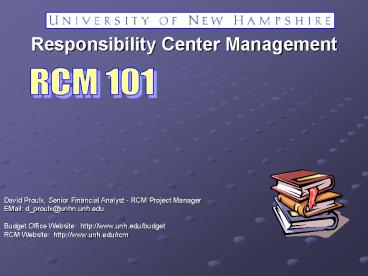RCM 101 PowerPoint PPT Presentation
1 / 16
Title: RCM 101
1
Responsibility Center Management
RCM 101
David Proulx, Senior Financial Analyst - RCM
Project Manager EMail d_proulx_at_unhn.unh.edu
Budget Office Website http//www.unh.edu/budge
t RCM Website http//www.unh.edu/rcm
2
RCM 101
- Old
- Budget
- System
RCM Model
3
RCM 101
- RCM
- Budget
- System
RCM Model
4
RC Units
RCM 101
RCM Model
Colleges and Related Service Units College of
Life Sciences and Agriculture College of Liberal
Arts College of Engineering and Physical
Sciences Whittemore School of Business and
Economics School of Health and Human services UNH
- Manchester Library Student and Community Life
Units Student Affairs Housing Hospitality
Services Intercollegiate Athletics Whittemore
Center Arena
Research and Public Service Units Cooperative
Extension Research and Public Service New
Hampshire Public Television Institute for Earth,
Oceans, and Space Governance, Advancement
and Infrastructure Units Facilities
Services Computing and Information
Services General Administration Academic Affairs
5
RCM Principles
RCM 101
RCM Model
- 1. Create incentives for good management
- 2. Fairness/Simplicity
- 3. Unit plans must align with Universitys
mission and strategic plan - 4. Smooth transition - no redistribution of
resources - 5. Credible governance mechanisms required to
prevent unhealthy internal competition - 6. Same rules for all operations academic,
research, auxiliary, administrative
6
RCM Principles, cont.
RCM 101
RCM Model
- RCM principles/formulas apply to the RC unit
level. - RC units receive all revenue and are responsible
for all expenditures generated by their
activities. - RC units carry forward excess funds from one year
to next and manage reserves at the unit level. - Each RC unit determines how to manage RCM within
their unit. - RCM is not a cost accounting model but rather a
general incentive/allocation model.
7
RC Unit Revenues
RCM 101
RCM Model
- Direct revenues - fees, sales of goods/services,
gifts, grants/contracts, endowment income - Allocated revenues
- Undergraduate tuition - based on weighted credit
hours taught over the past two years. Weights
are based on historical average expense per
credit hour. - Graduate tuition - based on enrollment
- State Appropriations - based on faculty salaries
- Indirect Cost Revenue - based on actual indirect
costs generated - Weightings are COLSA 1.0, WSBE 1.0, SHHS 1.0,
CEPS 1.5, COLA .8
8
RC Unit Expenses
RCM 101
RCM Model
- Direct Expenses - salaries, wages, fringe
benefits, equipment, travel, supplies, other
direct expenses. - Allocated expenses (overhead)
- Facilities Services (maintenance, utilities,
housekeeping, grounds and roads, RR) - based on
net square feet (15.40 per NSF) - General Administration (President, Research,
Finance Administration, Student Affairs, and
support units reporting to VPs) - based on prior
fiscal year revenues and personnel expenses.
Average rate 11 of total revenues. - Academic Affairs (Provost, Registrar, Financial
Aid Office, Admission and other units reporting
to Provost) - based on prior fiscal year revenues
and personnel expenses. Average rate 7 of
total revenues.
9
Balancing Adjustment
RCM 101
RCM Model
- Major principle of RCM was that no unit would
begin better - or worse off than they would have been under the
old - system thus they were held harmless
- A "balancing adjustment" was used to bring Units
into RCM - in a "revenue neutral" budget position
- Balancing adjustments are permanent but not
inflated
10
The University Fund
RCM 101
RCM Model
- Balancing adjustments do not inflate and are
funded from state appropriations. - Inflation proceeds become the University Fund
- University Fund is flexible central funding to
allocate based on strategic priorities of the
institution - Managed by the Central Budget Committee (CBC)
- Units make requests via strategic plans to their
VP. VP brings requests before the CBC. CBC
decides to provide permanent, one time or no
funding.
11
Reserves
RCM 101
RCM Model
- Under RCM, unspent funds at year end are
automatically added to the School/College fund
balance. This required a change in Board of
Trustee policy. - RC units are obligated to meet an agreed upon
minimum fund balance level (initially 1 of prior
year expenditures and transfers). - RC units can access reserves up to 1/3 of
balance with Dean/Director approval only
remainder with VP approval. - Unit reserves reduce dependence on limited
central reserves
12
Current Status
RCM 101
RCM Model
- Fifth year of RCM
- Increased discussion/understanding about
budgetary impact of decisions made by faculty and
deans - More collaborative budget process at
institutional and unit levels - Has improved attentiveness to student needs
more sections, new programs, restructuring of
existing programs - Service units redesigning processes to increase
efficiency
13
Current Status, cont.
RCM 101
RCM Model
- RCM has facilitated strategic planning at the
unit level long term vs. short term view - Institutional leaders focus on institutional
strategic issues vs. small dollar budgetary
requests - Attentiveness to all categories of money rather
than just General fund
14
(No Transcript)
15
(No Transcript)
16
Purpose of Review
RCM 101
RCM Model
- Model is not perfect
- Ensure that model does not impede progress toward
reaching goals outlined in the Academic Plan - Need to understand impact of perceived and actual
incentives/ disincentives created by RCM. - Understand if governing mechanisms are working as
intended - Changes will be made to the model after the
review process - Ensure as much understanding of the RCM across
the University as possible

